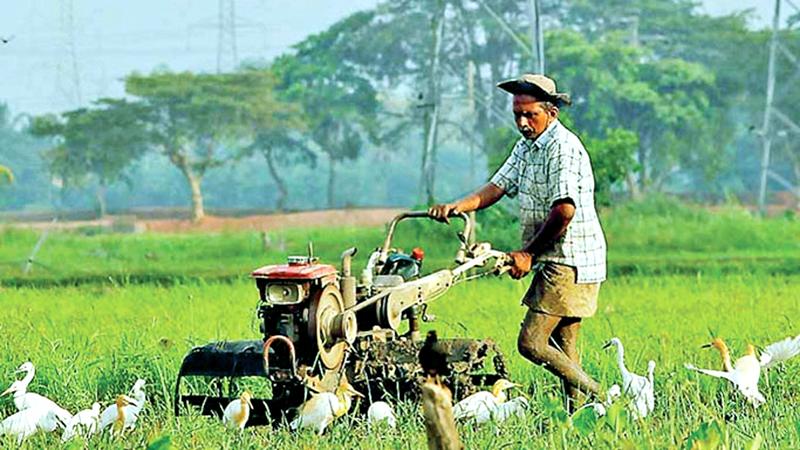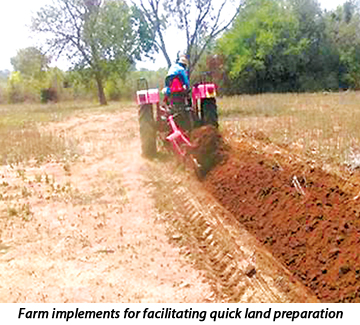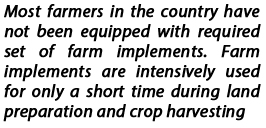
Continued from October 11
Support services for climate smart agriculture
An appropriate way to build resilience to climate change by local agriculture is to develop and adopt packages of adaptation strategies and practices targeted to each specific agriculture production system.
According to available literature, building resilience can be briefly described as the creation of an ability of a system to bounce back or return to normal functioning after climatic adversity.
 For example, management strategies, such as quick land preparation immediately after the onset of seasonal rains play a significant role for adaptation to climate change. For this purpose, presently in most farming communities, family labour is not adequately available and hired labour is not affordable due to high cost involved.
For example, management strategies, such as quick land preparation immediately after the onset of seasonal rains play a significant role for adaptation to climate change. For this purpose, presently in most farming communities, family labour is not adequately available and hired labour is not affordable due to high cost involved.
As a result,there is a need to consider the use of mechanised farm implements as an adaptation strategy.
However, most farmers in the country have not been equipped with required set of farm implements. Farm implements are intensively used for only a short time during land preparation and crop harvesting.
 Hence, particularly small-holder farmers are reluctant to maintain their own collection of farm implements.
Hence, particularly small-holder farmers are reluctant to maintain their own collection of farm implements.
Hiring implements from private owners is also expensive and availability is not assured at the required time in most cases.
Therefore, establishing farm implement rental centres at the community level serves as a support service to facilitate farm mechanisation and ensure quick land preparation.
Some support services, such as management packages to promote the buildup of resilience in the affected farming systems include:
a). Providing a facility for hiring farm implements,
b). Re-promoting the Aththam method in labour use particularly in hill agriculture,
c). Practising the bethma method in seasons having water shortages,
d). Installing electrified fences to protect crops from major wild animal pests,
e). Introducing crop insurance schemes particularly for commercial scale farming,
f). Introducing value-added land races for different climatic regions,
g). Producing byproducts from adapted crops and
h). Establishing effective market chains.
a). Facility for hiring farm implements
Providing a facility for hiring farm implements through a cooperative system or under the execution of a Government organisation would play a significant role in popularising farm mechanisation particularly among small holder farmers and contribute to building up resilience to climate change.
In the case of light implements, such as hoe, garden knife, sickle, hand weeder and knapsack sprayer, a required collection can be maintained by individual farmers.
In contrast, the need for providing a hiring service arises for heavy implements.
 Some heavy implements required for farming include two wheel tractors, four wheel tractors, minimum scale paddy seed cleaners, paddy seed processing machines, ridge and furrow makers, bund makers, highland inter-cultivators (backpack and walking types), highland seeders (injector type), grass cutters, water pumps (2 and 4 inches), power sprayers, multi choppers and combine harvesters.
Some heavy implements required for farming include two wheel tractors, four wheel tractors, minimum scale paddy seed cleaners, paddy seed processing machines, ridge and furrow makers, bund makers, highland inter-cultivators (backpack and walking types), highland seeders (injector type), grass cutters, water pumps (2 and 4 inches), power sprayers, multi choppers and combine harvesters.
Therefore, development of a support policy to provide a cooperative facility or Government agency is required by farming communities for hiring appropriate farm implements at the required time at an affordable cost.
b). Re-promotion of the Aththam method
The Aththam method has been a system of effective family labour use on mutual sharing basis since ancient times in this country.
In the case of rain-fed farming communities in hilly areas, the use of heavy farm implements is difficult due to the sloping of the terrain.
In these hilly areas, the re-introduction of traditional labour sharing arrangements particularly for peak times, such as land preparation, transplanting and harvesting should be considered.
Seasonal crop based hill agriculture has been the major system of farming historically in areas, such as Wahakotte, Dambawa, Selagama, Walmoruwa, Yatawatte, Deevilla, Mailapitiya, Bolape, Marassana, Adikarigama, Malulla, Hapuwala, Hanguranketha, Rikillagaskada, Mathurata, Mandaramnuwara, Walapone, Nildandahinna, Harasbedda, Kotambe, Galauda, Udupussellawa, Doragala, Dawatagas, Samanpura, Baragas, Keppetipola, Bogahakumbura, Welimada, Mirahawatte, Bandarawela, Boralanda, Ettampitiya, Haliela, Badulla, Wewatenna, Meegakivula, Kandeketiya, Karametiya, Kivullinda, Medamahanuwara, Hunnasgiriya, Udadumbara, Kalugala, Padupola, Udukumbura, Madugalla and Rambukwella.
Expert consultation will be required to develop strategies for the re-introduction of the Aththam method for areas practising hill agriculture.
Farm implements for facilitating quick land preparation
c). Re-promotion of the bethma method
The Bethma method is a system of land allocation particularly in tank villages in the dry and semi-dry areas for seasonal crop cultivation when the availability of water for rice farming in the entire paddy tract is not adequate.
Depending on the availability of tank water storage, a portion of the paddy tract is selected for crop cultivation in the season. In the selected area, each land owner receives a land parcel for farming. In some cases, the land parcel received may be owned by another farmer and it is only a provision of cultivation rights for the season.
The farmers who received cultivation rights have the understanding for safe use of the land during the season and hand it over to the owner without making any damages to the property inclusive of irrigation terraces and field canals.
The occurrence of more frequent water shortages for crop cultivation in village tank areas due to climate change effects could renew the need for re-promotion of this traditional land use strategy.
d). Establishment of electrified fences
Most local farming systems are closely associated with wildlife reservations and as a result, damages to crops and farm lands from wild animals have been a major constraint to crop production.
A research study conducted in Galgamuwa identified the animals responsible for the damage to farming lands.
The most common animals include: elephant (Elephasmaximus), boar (Susscrofa), deer (Axis axis), monkey (Rhesus macaque), porcupine (Hystrixindica), palm civet (Viverriculaindica), squirrel (Callosciurusprevostii), Indian palm squirrel (Funambuluspalmavum), peacock (Pavocristatus) and Indian star tortoise (Geocheloneelegans).
Among them, crop damages have been most severe from elephant, boar, deer and monkey. This is also the case in most other farming tracks associated with wildlife reservations.
Pilot scale demonstrations, to establish electrified fences have proven to be a successful strategy particularly for three among major animal pests: elephant, deer and boar. In areas where cable power supply is not available, solar energy has been successfully used as a nature friendly and cost effective alternative source of electrical power.
Some farmers have adopted the practice of using solar energy based electrified fences at cultivation plot levels, but this practice needs further development and expansion with necessary policy support.
e). Introduction of crop insurance schemes
In case of commercial scale farming, crop damages and reduced yields have been reported forsome seasonal high value crops, such as potato, cabbage, carrot, tomato, capsicum, bottle guard, bitter gourd, ridge gourd, chilli, onion and maize due to unexpected dry spells experienced during the growing season.
These types of damages have been aggravated by climate change effects during the past few decades. Suicide cases of farmers due to such crop failures have also been reported.
The introduction of a crop insurance scheme would financially help protect farmers during periods of unexpected crop losses caused by adverse weather.
Provision of a crop insurance scheme has been a common strategy in many other countries.
Under changing climatic conditions, new policy supports are required for the introduction and promotion of a comprehensive insurance scheme particularly for commercial scale farming of high value crops in risk areas.
f). Value addition on land races
Land races of food plants have been capable of surviving even under adverse climatic conditions compared to newly improved crops. For example, conventional land races in the country include palmyrah palm (Borassusflabellifer) which has been native to the Indian subcontinent and Southeast Asia, woodapple (Limoniaacidissima) which has been a native tree to Sri Lanka and India, margosa (Azadirachtaindica) which has been native to the Indian subcontinent, tamarind (Tamarindusindica) although it originated from Tropical Africa, toddy palm (Caryotaurens) which has been naturally occurring in the wet zone and jackfruit (Artocarpusheterophyllus) which originated from ancient cultivation in India.
The palmyrah palm has been grown dominantly in districts of Jaffna, Kilinochchi, Mullathivu,Mannar, Vavunia, Trincommallee, Baticaloa and some parts of adjacent districts. The sap extracted from this plant has been traditionally used for producing jaggery, treacle and toddy.
The dried leaflets of the plant have been used for making bags and mats for community use and income. Similarly, plants, such as wood apple, margosathough it is not a food crop and tamarind have been more commonly grown in districts of Puttalam, Kurunegala, Anuradhapura, Polonnaruwa, Ampara, Moneragala, Hambantota and some parts of the adjacent districts.
The pulp of the fruit of wood apple has been used as fresh fruit. It can also be used for jam, syrup and bottled drink for added value. Margosa plant has been used for medicinal purposes. Its pesticide properties can be exploited for value addition. The brown pulp around the seeds of tamarind plant has been used for seasoning curries, chutneys and medicinal purposes. For added value, this pulp can be used for making toffees and other sweet meets.
Toddy palm and jackfruit plants have been most commonly and naturally grown in the districts of Kalutara, Galle, Matara, Ratnapura, Kegalla, Kandy, Matale, Nuwara Eliya, Badulla and some parts of the adjacent districts.
Toddy palm sap tapped from the flower inflorescences has been used for making toddy, treacle and jiggery. All these products can be value added. In addition, sago has been processed from the trunk.
The unripe fruit of the jackfruit has been used as a vegetable for different tastes (embulpolos, mellumpolos, kirikos, kosmelluma, kosniyambalawa) and the ripe fruit as a desert.
In addition to the above examples, many land races which show resilience to climate change under different local agro-ecological environments show significant potential for value addition.
Value added products from these land races would help assure economic survival of rural communities, particularly during climatic adversity.
It is also important to utilise non-destructive means of harvesting plant parts from land races to ensure the sustainable use of this valuable plant genetic resource within village communities.
g). Byproducts from adapted crops
Rice has been the crop most adapted for seasonal farming in Sri Lanka. Being the staple of the nation, rice has a strong local demand for domestic consumption. In addition, it has a longer keeping quality under domestic environmental conditions. This is also the case for most crops yielding dry products, such as maize, finger millet, green gram, black gram, cowpea, soybean, groundnut and dry chilli.
However, for crops yielding perishable products, such as most fruits and vegetable, a problem arises with excess supplies.
For example, in some farming communities where most farmers cultivate only a limited number of perishable crops, the prices of produce typically decline during harvesting periods when produce is more abundant.
Tomato widely grown in the Matale district, brinjal in the Anuradhapura district and pumpkin in the Moneragala district, lime in the semi-wet and semi-dry areas are classic examples of price decline at the harvest time.
Diversion of the excess production for processing into byproducts with better keeping quality would help mitigate the problems associated with managing excess production.
For example, byproducts, such as sauce from tomato and fruit juice from lime are some affordable industries that could benefit resource poor local farmers.
New policy supports are required for promotion and initiation of value-added processing industries in farming areas.
